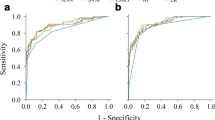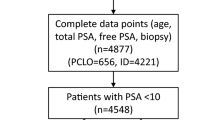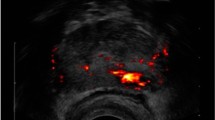Abstract
Introduction
Complex statistical models utilizing multiple inputs to derive a risk assessment may benefit prostate cancer (PC) detection where focus has been on prostate-specific antigen (PSA). This study develops a polychotomous logistic regression (PR) model and an artificial neural network (ANN) for predicting biopsy results, particularly for clinically significant PC.
Methods
There were 3,025 men undergoing TRUS-guided biopsy (BX) with PSA <10 ng/ml selected. BX outcome classified as benign, atypical small acinar proliferation or high-grade prostatic intraepithelial neoplasia (ASAP/PIN), non-significant (NSPC) or clinically significant PC (CSPC). PR and ANN models were developed to distinguish between BX categories. Predictors were age, PSA, abnormal digital rectal examination (DRE), positive transrectal ultrasound (TRUS) and prostate volume.
Results
Among the BXs, 44% were benign, 14% ASAP/PIN, 16% NSPC and 25% CSPC. Median age, PSA and volume were 64 years, 5.7 ng/ml and 50 cc. TRUS lesion was present in 47%, and DRE was abnormal in 39%. PR and ANN models did not differ on percentage BX outcomes correctly predicted (55, 57%, respectively) and were equally poor for both ASAP/PIN (0%) and NSPC (2%). For PR and ANN, 74–78% ASAP/PIN predicted benign, 2% NSPC and 20–24% CSPC. For NSPC, 69–71% predicted benign, 27–29% CSPC. Benign outcomes were well identified (86–88%), although 12–13% classified CSPC. CSPC was correctly identified in 65–66% with misclassifications largely benign (33% for PR and ANN).
Conclusions
Neither PR nor ANN was able to distinguish between the four biopsy outcomes: ASAP/PIN and NSPC were not distinguished from benign or CSPC. ANN did not perform better than PR. Inclusion of additional predictors may increase the performance of statistical models in predicting BX outcome.


Similar content being viewed by others
Abbreviations
- ANN:
-
Artificial neural network
- ASAP:
-
Atypical small acinar proliferation
- BX:
-
TRUS guided prostate biopsy
- CI:
-
Confidence intervals
- DRE:
-
Digital rectal examination
- OR:
-
Odds ratios
- PC:
-
Prostate cancer
- CSPC:
-
Clinically significant PC
- NSPC:
-
Non-significant PC
- PIN:
-
High-grade prostatic intraepithelial neoplasia
- PR:
-
Polychotomous logistic regression
- PSA:
-
Prostate-specific
- TRUS:
-
Transrectal ultrasound
References
Porcaro AB, Migliorini F, Romano M et al (2010) Investigative clinical study on prostate cancer: on the role of the pretreatment total PSA to free testosterone ratio in selecting different biology groups of prostate cancer patients. Int Urol Nephrol. doi:10.1007/s11255-009-9669-z
Suardi N, Capitanio U, Chun FK et al (2008) Currently used criteria for active surveillance in men with low-risk prostate cancer: an analysis of pathologic features. Cancer 113:2068–2072
Schroder FH (2008) Screening for prostate cancer (PC)—an update on recent findings of the European Randomized Study of Screening for Prostate Cancer (ERSPC). Urol Oncol 26:533–541
van Renterghem K, Van Koeveringe G, Achten R et al (2010) A new algorithm in patients with elevated and/or rising prostate-specific antigen level, minor lower urinary tract symptoms, and negative multisite prostate biopsies. Int Urol Nephrol 42(1):29–38
Partin AW, Kattan MW, Subong EN et al (1997) Combination of prostate-specific antigen, clinical stage, and Gleason score to predict pathological stage of localized prostate cancer. A multi-institutional update. JAMA 277:1445–1451
Kattan MW, Eastham JA, Stapleton AM et al (1998) A preoperative nomogram for disease recurrence following radical prostatectomy for prostate cancer. J Natl Cancer Inst 90:766–771
Karakiewicz PI, Benayoun S, Kattan MW et al (2005) Development and validation of a nomogram predicting the outcome of prostate biopsy based on patient age, digital rectal examination and serum prostate specific antigen. J Urol 173:1930–1934
Djavan B, Remzi M, Zlotta A et al (2002) Novel artificial neural network for early detection of prostate cancer. J Clin Oncol 20:921–929
Rodvold DM, McLeod DG, Brandt JM et al (2001) Introduction to artificial neural networks for physicians: taking the lid off the black box. Prostate 46:39–44
Stephan C, Cammann H, Jung K (2005) Artificial neural networks: has the time come for their use in prostate cancer patients? Nat Clin Pract Urol 2:262–263
Shariat SF, Karakiewicz PI, Suardi N et al (2008) Comparison of nomograms with other methods for predicting outcomes in prostate cancer: a critical analysis of the literature. Clin Cancer Res 14:4400–4407
Kranse R, Beemsterboer P, Rietbergen J et al (1999) Predictors for biopsy outcome in the European Randomized Study of Screening for Prostate Cancer (Rotterdam region). Prostate 39:316–322
Garzotto M, Beer TM, Hudson RG et al (2005) Improved detection of prostate cancer using classification and regression tree analysis. J Clin Oncol 23:4322–4329
Thompson IM, Pauler Ankerst D, Chi C et al (2007) Prediction of prostate cancer for patients receiving finasteride: results from the Prostate Cancer Prevention Trial. J Clin Oncol 25:3076–3081
Hekal IA, El-Tabey NA, Nabeeh MA et al (2010) Validation of Epstein criteria of insignificant prostate cancer in Middle East patients. Int Urol Nephrol. doi:10.1007/s11255-009-9670-6
Al-Ghamdi AM, Lockwood G, Toi A et al (2008) Extended pattern prostate biopsy does not minimize the volume-grade bias in prostate cancer detection. J Urol 179:1332–1334
Neill MG, Toi A, Lockwood GA et al (2008) Systematic lateral prostate biopsy—are the benefits worth the costs? J Urol 179:1321–1326
Toi A, Neill MG, Lockwood GA et al (2007) The continuing importance of transrectal ultrasound identification of prostatic lesions. J Urol 177:516–520
Greene F, Page D, Fleming I (eds) (2002) American Joint Committee on Cancer staging manual, 6th edn. Springer, New York
Fleshner N, Gomella LG, Cookson MS et al (2007) Delay in the progression of low-risk prostate cancer: rationale and design of the Reduction by Dutasteride of Clinical Progression Events in Expectant Management (REDEEM) trial. Contemp Clin Trials 28:763–769
Schroder FH, Hugosson J, Roobol MJ et al (2009) Screening and prostate-cancer mortality in a randomized European study. N Engl J Med 360:1320–1328
Andriole GL, Grubb RL III, Buys SS et al (2009) Mortality results from a randomized prostate-cancer screening trial. N Engl J Med 360:1310–1319
Conti SL, Dall’era M, Fradet V et al (2009) Pathological outcomes of candidates for active surveillance of prostate cancer. J Urol 181:1628–1633 discussion 1633-1624
Snow PB, Smith DS, Catalona WJ (1994) Artificial neural networks in the diagnosis and prognosis of prostate cancer: a pilot study. J Urol 152:1923–1926
Eastham JA, May R, Robertson JL et al (1999) Development of a nomogram that predicts the probability of a positive prostate biopsy in men with an abnormal digital rectal examination and a prostate-specific antigen between 0 and 4 ng/mL. Urology 54:709–713
Stephan C, Cammann H, Semjonow A et al (2002) Multicenter evaluation of an artificial neural network to increase the prostate cancer detection rate and reduce unnecessary biopsies. Clin Chem 48:1279–1287
Naito S, Kuroiwa K, Kinukawa N et al (2008) Validation of Partin tables and development of a preoperative nomogram for Japanese patients with clinically localized prostate cancer using 2005 International Society of Urological Pathology consensus on Gleason grading: data from the Clinicopathological Research Group for Localized Prostate Cancer. J Urol 180:904–909 discussion 909-910
Chun FK, Haese A, Ahyai SA et al (2008) Critical assessment of tools to predict clinically insignificant prostate cancer at radical prostatectomy in contemporary men. Cancer 113:701–709
Dubin N, Pasternack BS (1986) Risk assessment for case-control subgroups by polychotomous logistic regression. Am J Epidemiol 123:1101–1117
Pinthus JH, Witkos M, Fleshner NE et al (2006) Prostate cancers scored as Gleason 6 on prostate biopsy are frequently Gleason 7 tumors at radical prostatectomy: implication on outcome. J Urol 176:979–984 discussion 984
Egevad L, Allsbrook WC, Epstein JI (2006) Current practice of diagnosis and reporting of prostatic intraepithelial neoplasia and glandular atypia among genitourinary pathologists. Mod Pathol 19:180–185
Moore CK, Karikehalli S, Nazeer T et al (2005) Prognostic significance of high grade prostatic intraepithelial neoplasia and atypical small acinar proliferation in the contemporary era. J Urol 173:70–72
Netto GJ, Epstein JI (2006) Widespread high-grade prostatic intraepithelial neoplasia on prostatic needle biopsy: a significant likelihood of subsequently diagnosed adenocarcinoma. Am J Surg Pathol 30:1184–1188
Kattan M (2002) Statistical prediction models, artificial neural networks, and the sophism “I am a patient, not a statistic”. J Clin Oncol 20:885–887
Kulkarni GS, Al-Azab R, Lockwood G et al (2006) Evidence for a biopsy derived grade artifact among larger prostate glands. J Urol 175:505–509
Acknowledgments
We would like to acknowledge the generous support of the Prostate Cancer Research Foundation of Canada in conducting this study.
Author information
Authors and Affiliations
Corresponding author
Rights and permissions
About this article
Cite this article
Lawrentschuk, N., Lockwood, G., Davies, P. et al. Predicting prostate biopsy outcome: artificial neural networks and polychotomous regression are equivalent models. Int Urol Nephrol 43, 23–30 (2011). https://doi.org/10.1007/s11255-010-9750-7
Received:
Accepted:
Published:
Issue Date:
DOI: https://doi.org/10.1007/s11255-010-9750-7




